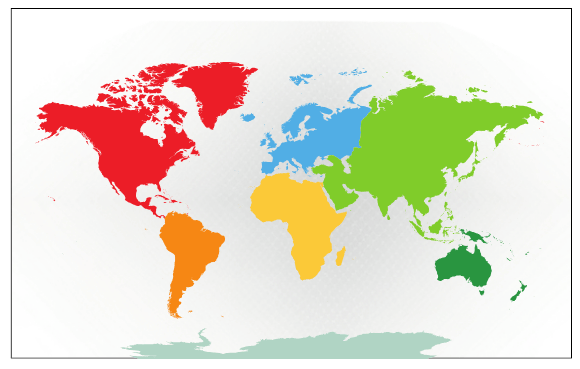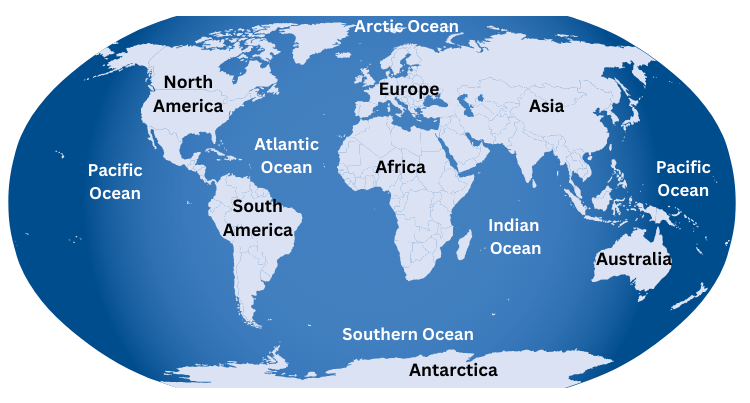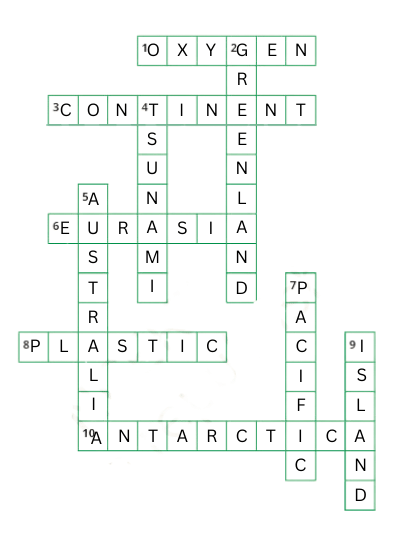Hello, dear students! We’re thrilled to welcome you to this exciting lesson on Oceans and Continents!
Our dedicated team of teachers, trained both in India and overseas, has thoughtfully prepared this lesson to make your learning as smooth and enjoyable as possible. Each concept, from the vast oceans to the diverse continents, is explained with care, so you can easily understand how our planet’s incredible features are connected and how they impact life across the globe.
As you dive into these topics, we encourage you to explore with curiosity and think about how continents and oceans shape the world we live in. Don’t hesitate to ask questions, share your ideas, and let your sense of wonder guide you. Remember, learning is a journey, and we’re here to support and cheer you on at every step.
Find Solutions for NCERT Class 6 Social Science Exploring Society: India and Beyond Chapter 2 “Oceans and Continents,” here.
The Big Questions?
1. What are oceans and continents? What are their names and their distribution?
Answer:
Oceans are large bodies of saltwater covering about 71% of Earth’s surface. They play a crucial role in regulating the planet’s climate, providing rain, and supporting marine life.
The five oceans are the Pacific, the largest and deepest; the Atlantic, the second largest; the Indian, bordered by Asia, Africa, and Australia; the Southern, encircling Antarctica; and the Arctic, the smallest.
Although they are listed as separate, all oceans are interconnected, with seawater constantly flowing between them, which helps sustain a rich diversity of marine life and supports the Earth’s water cycle.
Continents are large landmasses that form Earth’s primary land areas and support diverse ecosystems and human civilizations.
The seven continents are Africa, Antarctica, Asia, Australia, Europe, North America, and South America. These continents are distributed across both the Northern and Southern Hemispheres, with more land in the Northern Hemisphere.
Continents support life by providing habitats for various species, fertile lands for agriculture, mineral deposits, and resources for human survival and development. Each continent has contributed to the evolution of human societies, influencing cultures, economies, and global interactions.
2. In what ways do oceans and continents impact life on Earth, including human life?
Answer:
Oceans play a vital role in regulating the Earth’s climate, providing rain through the water cycle, and sustaining marine life.
Oceans are responsible for producing more than half of the world’s oxygen through marine flora like algae, which is why they are often called “the planet’s lungs.” Oceans also support a rich diversity of marine life, from tiny algae to large whales, and serve as a major source of food for humans.
They have influenced human history by enabling trade, migration, and cultural exchanges between distant regions.
Oceans also affect human life through natural disasters like tsunamis and cyclones.
Continents, on the other hand, host diverse ecosystems that provide habitats for various plants and animals. They are home to human civilizations, shaping cultures, economies, and societies. Continents offer fertile lands for agriculture, resources for industries, and space for human settlement.
The distribution of continents affects climate patterns and has influenced human migration and settlement throughout history. Each continent has unique geographical features, from mountains and deserts to forests and plains, that contribute to the richness of life on Earth.
Both oceans and continents play a crucial role in shaping the climate of the Earth. They affect all aspects of plant and animal life, and therefore, human life too. We see their impact throughout our history and culture, and in our daily lives.
LET’S EXPLORE (Page 29)
What are the circular lines in each map called? And do you know what the lines radiating out of the two poles are called? (Hint: you studied them in the previous chapter, but here they are presented differently.)
Answer:
The circular lines in the map are called Latitudes. The lines radiating out of the two poles are Longitudes.
Which hemisphere holds more water?
Answer:
The Southern Hemisphere holds more water.
What do you think could be the approximate proportion of water to land in the Northern Hemisphere? And in the Southern Hemisphere? Discuss in groups.
Answer:
The approximate proportion of water to land in the Northern Hemisphere is 3:2, or three parts of water to two parts of land.
The approximate proportion of water to land in the Southern Hemisphere is 3: 1, or three parts of water to one part of land.
Are all the oceans connected with one another, or are there separations between them?
Answer:
All the oceans are connected with one another. There are no separations between them.
THINK ABOUT IT (Page 31)
If there is such abundance of water on the planet, why is there so much talk of ‘water scarcity’ or a ‘water crisis?
Answer:
It is a fact that the Earth has an abundance of water. The oceans together hold most of the water available on the planet. But this water is salty and unfit for human consumption, agriculture, or most industrial uses.
On the other hand, freshwater, which is essential for drinking, farming, and many other activities, is scarce. Freshwater makes up a very small proportion of the planet’s water resources; it is found in glaciers, rivers, lakes, in the atmosphere and also underground (groundwater).
This limited supply of freshwater is not distributed evenly across the globe, and in many regions, it is scant due to various factors:
Overpopulation: Ever growing population increases the demand for freshwater, stressing the available resources and leading to severe water scarcity.
Pollution: Freshwater sources such as rivers, lakes, and groundwater are often polluted by industrial waste, agricultural runoff, and improper waste disposal, decreasing the amount of fresh potable water available and creating a ‘water crisis’.
Climate Change: Changes in weather patterns and global warming can lead to droughts, changing the quantity of freshwater available in many areas.
Inefficient Water Use: In many regions, water is used inefficiently in agriculture, industry, and daily life, leading to wastage and depletion of freshwater supplies.
Depletion of Groundwater: Extracting too much groundwater for farming and household use can drain underground water reserves, making water scarcity even worse.
What ways of saving water are you aware of? Which ones have you seen practised at home, at your school, and in your village, town or city?
There are several effective ways to save water, many of which are practiced in homes, schools, and communities:
Rainwater Harvesting: Collecting and storing rainwater for later use is an effective way to reduce dependency on groundwater and municipal water supplies. This method is practiced in many households and schools, particularly in water-scarce regions.
Repairing Leaks: Regularly checking and repairing leaking taps, pipes, and toilets can save significant amounts of water that would otherwise be wasted.
Using Water-Efficient Appliances: Installing water-saving devices like low-flow showerheads, faucets, and dual-flush toilets helps reduce water consumption at home and in schools.
Recycling Water: Using greywater (wastewater from baths, sinks, washing machines, etc.) for gardening or flushing toilets can reduce the demand for freshwater.
Drip Irrigation: In agriculture, drip irrigation systems deliver water directly to the roots of plants, minimizing wastage and ensuring efficient use of water. This method is often used in farms and gardens.
Water-Saving Campaigns: Educational campaigns in schools and communities raise awareness about the importance of conserving water and encourage people to adopt water-saving practices in their daily lives.
These practices, when widely adopted, can make a significant difference in conserving water and mitigating the effects of water scarcity.
I have seen rain water harvesting in our school terrace. The rain water is stored in a reservoir on the terrace and used to supplement municipal water which becomes scarce during the peak of summer.
At home my father ensures that all leaky faucets or pipes are replaced instantly to avoid wastage. Besides we fill a mug with water to use for brushing our teeth or shaving instead of leaving the tap water running. We have installed low flow showers and dual- flush toilets to save water. Water is recycled whenever possible for watering plants and cleaning floors etc.
LET’S EXPLORE (Page 32)
Locate the five oceans and, in the table below, mark the hemisphere or hemispheres they belong to
| Northern Hemisphere | Southern Hemisphere | |
| Pacific Ocean | ||
| Atlantic Ocean | ||
| Indian Ocean | ||
| Southern Ocean | ||
| Arctic Ocean |
Answer:
| Northern Hemisphere | Southern Hemisphere | |
| Pacific Ocean | Pacific Ocean | Pacific Ocean |
| Atlantic Ocean | Atlantic Ocean | Atlantic Ocean |
| Indian Ocean | Indian Ocean | Indian Ocean |
| Southern Ocean | Southern Ocean | |
| Arctic Ocean | Arctic Ocean |
LET’S EXPLORE (Refer to the Diagram on Page 36)
Counting the numbers of squares, name the largest continent and the smallest.
Answer:
Largest continent = Asia (44 squares)Smallest continent= Australia (8 squares)
Which one is larger — North America or South America? Africa or North America? Antarctica or Australia?
Answer:
North America (17squares)
South America (18 squares) – South America is larger
Africa (30 squares)
North America (17 squares) – Africa is larger
Antarctica (13 squares) – Antarctica is larger
Australia (8 squares)
Re-colour the diagram by having a single colour for Europe and Asia and rename the result as ‘Eurasia’. Compare its size with South America’s.
Answer:
Enjoy recolouring the diagram with a single colour for Europe and Asia andrename it Eurasia.
Eurasia (54 squares)
South America (18 squares)
Eurasia is much larger than South America.
Write down the list of continents from the smallest to the largest.
Answer:
1. Australia (8 squares)
2. Europe (10 squares)
3. Antarctica (13 squares)
4. North America (17 squares)
5. South America (18 squares)
6. Africa (30 squares)
7. Asia (44 squares)
Questions, activities and projects
1. Explain the following terms:
(a) Continent
Answer:
A continent is a large, continuous expanse of land on Earth. The world can be divided into seven continents: Africa, Antarctica, Asia, Australia, Europe, North America, and South America.
While some continents, like Australia, are entirely surrounded by water, others, like Europe, Asia, and Africa, are connected to each other by land.
Despite these connections, the continents are usually considered separate due to their distinct cultures, and histories.
(b) Ocean
Answer:
An ocean is a vast body of saltwater that covers a large portion of the Earth’s surface. There are five major oceans: the Pacific Ocean, Atlantic Ocean, Indian Ocean, Arctic Ocean, and Southern (or Antarctic) Ocean.
Oceans are interconnected, and they support a diverse range of marine life. The oceans together hold most of the water available on the planet. But this seawater is salty and unfit for consumption by most land animals, including humans.
Oceans also play a vital role in the Earth’s water cycle, climate, and weather patterns.
(c) Island
Answer:
An island is a piece of land that is completely surrounded by water. Islands are smaller than continents. Some islands are large, like Greenland, while others are small. For example, India has more than 1300 islands, including the Andaman and Nicobar Islands in the Bay of Bengal and the Lakshadweep Islands in the Arabian Sea. Islands can be found in oceans, seas, rivers, and lakes.
2. Let us draw (Page 39)
Without looking at the maps in this chapter, draw the continents free hand on a sheet of paper and colour them. Then compare your drawing with the map of oceans and continents in the chapter.
Answer:
Do it yourself after carefully studying the shape and position of each continent. It does not have to be perfect as long as you get the positions and shapes right.

3. Let us do –
On the outline map of the world given below, label all the continents and oceans.

Crossword (Page 40)

Across
1. Abundantly produced by the oceans – Oxygen
3. A large expanse of landmass – Continent
6. A large continent of which India is a part – Eurasia
8. A major source of pollution of the oceans – Plastics
10. The coldest continent – Antarctica
Down
2. The largest island on Earth – Greenland
4. A huge destructive wave from the ocean – Tsunami
5. The smallest continent – Australia
7. The largest body of water on the Earth – Pacific
9. A landmass (but not a continent) surrounded
by the sea or ocean – Island
Frequently Asked Questions on NCERT Solutions for Class 6 Social Science Exploring Society: India and Beyond Chapter 2 “Oceans and Continents”
Our team of knowledgeable subject experts has carefully prepared these solutions to make sure they are not only accurate but also engaging and easy to follow. Each concept is explained in a simple, clear way, so learning becomes enjoyable, and you can understand the material without any trouble.
We encourage you to explore these solutions, as they’re designed to clear any doubts and deepen your understanding of the lessons. Plus, you can download the free PDFs anytime for quick access!
And that’s not all—there’s more exciting study material and helpful resources on the way! Keep visiting our website and make sure to sign up for our email list to stay updated and get free access to all the new content. We’re here to support you—happy learning!
Yes indeed! You can download the free PDF versions of these excellent solutions anytime (please look towards the top of the page)!
Certainly! Our team of expert teachers has carefully considered any questions you may have about the lesson and has crafted these thorough solutions to walk you through each important detail. These solutions not only highlight the finer points but also capture the main ideas, ensuring you gain a clear understanding of the entire chapter.
We suggest beginning by reading the lesson thoroughly, then reviewing the solutions to absorb the explanations fully. To enhance your learning experience, take some time to explore a world map and locate the major oceans and continents. Familiarize yourself with the Pacific, Atlantic, Indian, Southern, and Arctic Oceans, along with continents like Asia, Africa, Europe, North and South America, and Australia. This hands-on approach will help you better visualize the lesson and reinforce your understanding of the concepts.
Before your exam, be sure to go over the solutions and practice answering questions under timed conditions. This is an essential step—it not only sharpens your skills but also builds confidence, ensuring you’re well-prepared for any questions that come your way.
With regular practice, you’ll be ready to take on any challenge with ease. Best of luck, and remember, we’re always here to support you on your learning journey!
Are you feeling overwhelmed by too many study options or unsure about where to start? You’re not alone! Many students face the same challenges, but the good news is, we’re here to help.
At educationroundtheworld.com, our expert teacher-mentors are dedicated to guiding you every step of the way. We understand how frustrating it can be to feel stuck or stressed. That’s why we offer personalized coaching tailored just for you. With our support, you can say goodbye to confusion and unnecessary pressure.
Here’s how it works: Simply reach out to us or book your first session now. From there, we’ll create a clear, stress-free plan that’s focused on your success. Imagine a study experience where you feel confident, empowered, and ready to reach your full potential!
The path to success is just one step away—take it with us today!


